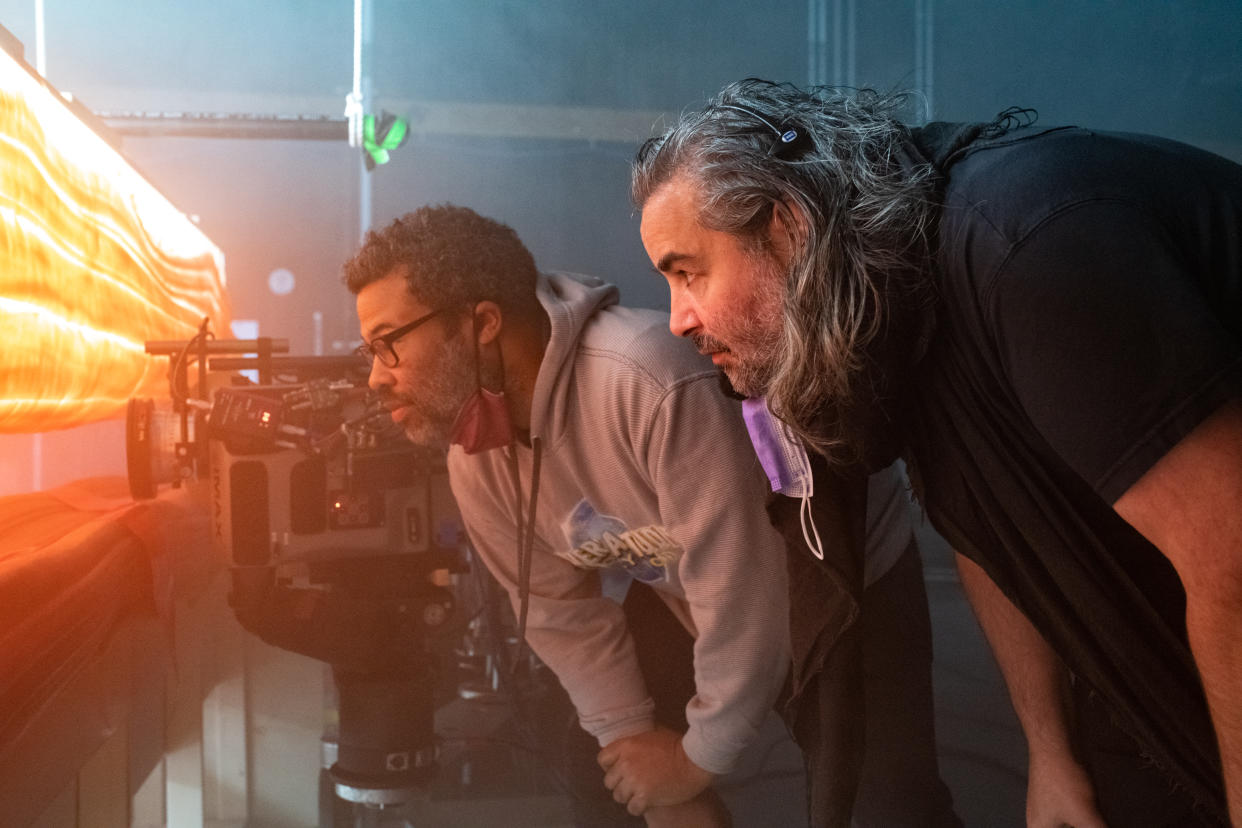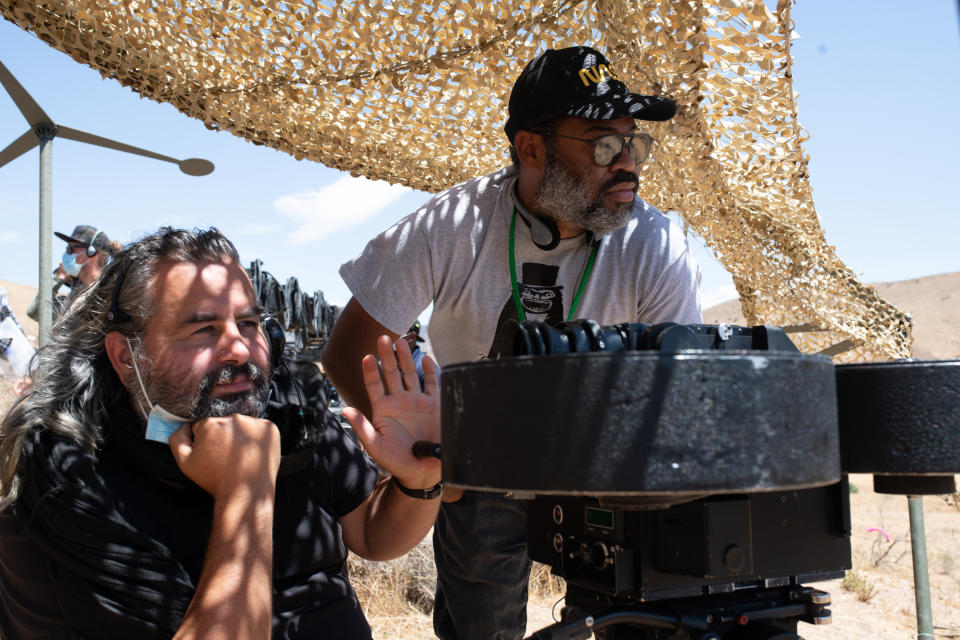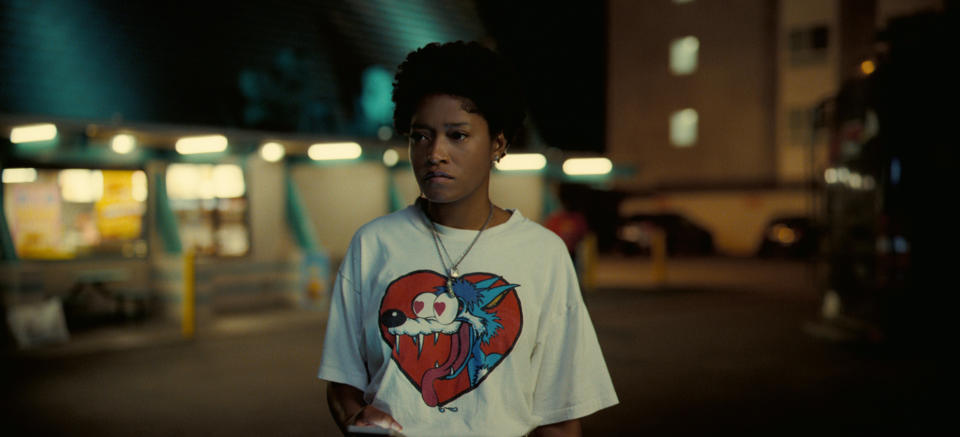Jordan Peele and Hoyte van Hoytema Knew the Less We Saw of the ‘Nope’ Chimp Attack, the Scarier It Would Be

- Oops!Something went wrong.Please try again later.
- Oops!Something went wrong.Please try again later.
Writer, producer, and director Jordan Peele took a major leap forward in terms of both conceptual ambition and logistical scale with his alien invasion epic “Nope,” but luckily he found the perfect partner for his big leap in cinematographer Hoyte van Hoytema. Working together for the first time, Peele and van Hoytema created the perfect cinematic grammar for Peele’s combination of sweeping spectacle, social satire and penetrating character study; by combining cutting-edge technology with straightforward, classical storytelling techniques, they created a film as emotionally satisfying as it is visually awe-inspiring. The two filmmakers spoke with IndieWire about their collaboration and why they took a “less is more” approach to horror in their sci-fi masterpiece.
This conversation has been edited and condensed for clarity.
More from IndieWire
IndieWire: One of the things I really respond to in your work, Jordan, is the precision and elegance of your visual style. Where the camera is and how it moves and when you cut all feel very purposeful. How do you conceive your shots? Are you the kind of director who storyboards and pre-visualizes everything ahead of time, or do you and Hoyte respond to what the actors are doing on the day and shape your choices around that?
Jordan Peele: It’s a combination. I rely on some amazing storyboard artists in prep to help me figure out what I want it to look like, but I think of them as a jumping off point, because you quickly figure out that you really have to be one with the day. Hoyte is extremely eager to engage with the moment, and I’m an improviser — that’s my fallback pedigree. So I think the Jordan-Hoyte love affair is very much based on the idea that we’ve done all of the preparation we can do, but let’s throw that out and figure out what the day needs, and even more importantly, what the moment needs. Then a lot of the purposefulness comes, as you noted, in the edit. That’s where you can take jagged scraps and make something purposeful, or you can take something that is very orderly and regimented in the craft of it and mess it all up.
Hoyte van Hoytema: I’m not so much into storyboards because I always feel like they enslave me, but when I started interpreting Jordan’s as a notebook with very specific ideas representing the essence of what he wanted, I found that very helpful. There are a lot of specific things in this script that are based on the fact that you can just about see something but not, which is suggestive in a way that’s impossible to put into a storyboard. Storyboards don’t have movement, or a rhythm, or a feeling – but they’re a reminder of what’s essential.
That idea of what you just barely see versus what you don’t see at all is integral to the film’s effectiveness. Something like the Gordy scene where the chimp attacks the sitcom cast: What are your guiding principles in terms of figuring out how much to show and what to leave to the audience’s imagination?
Peele: I always talk with my collaborators about this idea that less is more, and that ultimately the audience’s imagination is set to their own nightmares. If you can suggest a murder’s happening around the corner, they’re going to come up with something better than you can with that information. So with Gordy, there’s a moment where he’s going in for some dark violence with the actress and we put it behind a sofa. This is something I learned at, I think maybe 13 years old: There’s a harrowing climactic scene in ‘The Prince of Tides’ where the violence is partitioned — we’re only allowed to see a piece of it, and that affected me early. So in all of my films, if the violence gets dark enough I’ll withhold some of it — both so as not to induce revulsion, but at the same time I’m going in for a darker moment in the audience’s mind than I could paint.
van Hoytema: There’s also this other thing that Jordan and I talked about in the beginning, which is that we are not necessarily showing things that our characters wouldn’t be able to see — we have to discover what’s happening through the eyes of our main characters. With the Gordy scene, for instance, the kid is hiding under the table and we literally put the camera where he’s sitting and film only from his point of view rather than place it in another position where we could get a better angle on it. Jordan was very meticulous about distributing the information in the right portions as if we were learning it with our characters. That’s why in the beginning we only see glimpses of Jean Jacket or hear it as opposed to later when we get a full view.

Glen Wilson/Universal Pictures
Peele: Stephen King wrote this book about the art of horror called ‘Danse Macabre,’ and he talks about the categories of terror, horror, and revulsion: terror being the expectation of something, horror being the moment you see the monster, and revulsion being the gross-out type of thing. That breakdown helped me ask myself what kind of horror storyteller I wanted to be — and basically I’m a terror guy. That’s the one where you have the audience’s imagination in the palm of your hand. But with ‘Nope’ I also really wanted to explore moments of horror — with Gordy, or with the digestion scene — which I hadn’t done as much with my previous movies.
I’m curious how you figure that all out on set. When you’re shooting something like the Gordy sequence, for example, how does it work on the day between the two of you in terms of blocking it all out?
Peele: The Gordy scene is actually a good example because it was the first day of shooting and we were figuring out a lot about ourselves. It was the first day where Hoyte set up a shot and said ‘Hey, look. What do you think?’ One of the first things we shot was Jupe’s point of view, and we had Terry Notary, an amazing performer, playing Gordy. We oversized the furniture so that Terry would be interacting with the environment at the right scale, to the point that even the teenage girl who’s being mangled is actually a tall woman. Basically, when you do this you foreshorten and Hoyte’s team helps conduct where to put everything so that it looks like it’s the correct size. It’s real old-school trickery. When Hoyte first set up that POV and we went through it, I think we all knew that it was going to be a magical shot.
Hoyte and I also talked about the camera, and the fact that we’re mimicking the movie’s story in the way that we’re trying to capture this impossibility. At one point I asked Hoyte to basically be a performer behind the camera — if the UFO is coming around, he has to really be afraid. I haven’t asked you Hoyte, did you ever feel like a performer?
van Hoytema: There are moments where you can get extremely engaged, for instance when Angel is looking up and he sees Jean Jacket looming over him and there are wind machines and everything. We’re shooting it and we don’t see the alien, but at the same time you have a camera on your shoulder and you’re imagining it and you become very reactive in your operating. You have to pretend this thing is there, and so like an actor you really get into it and start to believe in it and translate it back into your operating. And that can also happen in the smaller scenes, sometimes it’s very intimate when you’re operating a camera — when I shoot Keke Palmer, sometimes a tear is coming out of her eye a foot away from my face. I’m trying to hold my breath and it becomes very intimate and you do feel like you’re part of the performance.

Universal Pictures
There’s also an intimacy that comes from the way you move the camera in the film, which is very subtle and restrained in a way. The camerawork is very elaborately choreographed, but never in a way that’s showing off — it always serves the emotional effects you’re trying to achieve.
Peele: My general principle, and Hoyte was very reinforcing of this, is that everything you do has to have a reason. You’re not doing anything extra. Not doing more than you need to do. That takes a lot of choices away, and one of the reasons I really loved Hoyte as a collaborator is that he’s anti-contrivance. He can sniff out anything that you’re doing because you feel like it’s supposed to be done that way. He has a way of further stripping my sensibilities down and keeping it simple.
van Hoytema: It’s that old design principle that form follows function. I’m sensitive to when things become decorative just for the sake of it, and in my profession that happens a lot. People dress things up with trickery, and it’s sort of easy to make things look pretty and sleek and smooth. It’s much harder to strip things down to their essence. But Jordan is a purist.
Peele: There’s a paradox that I became aware of about a third of the way in, which is that on the one hand this is an incredibly elaborate technical adventure. I’ve never been in these big action moments like Hoyte has been, he’s a seasoned veteran, but for me driving around with a helicopter whipping up dust and horses and the camera whipping around from one side of the car to the other… it’s as much as you could possibly throw at a film. What was really cool for me was seeing how when it comes to the practical problem-solving side of things Hoyte never stops innovating and going extra, but in style and artistic taste it’s all very simple.
van Hoytema: Once you figure out what the assignment is, if you can boil it down then the rest is just technology. We end up with all these gadgets and tools and toys, but they all come in to fulfill a very specific function. That helicopter zipping around was just a way for us to blow up enough out so that you would actually believe it came from the force of Jean Jacket. It made sense for our helicopter to become our wind machine, but we weren’t using it to make gratuitous crazy aerial shots just because we had it.
Peele: Hoyte calls a long lens the ‘make it look pretty’ lens, and it’s hard to convince him to use a lens that is solely for the purpose of making a shot look good. He wants to present what’s out there, not to enhance it or try to butter it up. I find that approach really interesting and really addictive.
van Hoytema: I like it because it forces you to figure things out and make an extra thought jump that usually takes you closer to what you initially wanted. Jordan and I also thought a lot about the principle of the oner, of laying out everything in one shot. What is great about that is that you have to figure it out: You have the beginning of your shot, you have an ending, you have a middle piece; you have to be wide, you have to be tight. You build a ballet and then you play that ballet out and the ballet has its own rhythm, and doing that reveals the key to the scene. What is the scene about? What rhythm does it have to have? It very often helps to unlock what the scene is.
Peele: My first oner was the first scene in ‘Get Out,’ but it was the last scene I shot. When we did it, I realized how immersive it is and how much it can simplfy, and ‘Nope’ is all about immersiveness. It’s all about being young Jupe, or being O.J. or Angel, because we truly felt that if we could give the audience the impossibility of being in the presence of something from another world and to have that awe, that would be worth the price of admission.
Best of IndieWire
Sundance 2023 Movie Deals So Far: Music Box Films Nabs 'Other People's Children'
New Movies: Release Calendar for January 6, Plus Where to Watch the Latest Films
Sign up for Indiewire's Newsletter. For the latest news, follow us on Facebook, Twitter, and Instagram.

